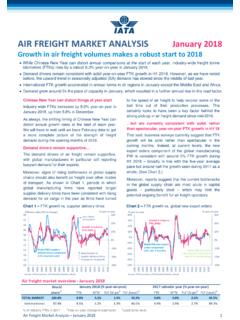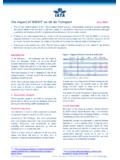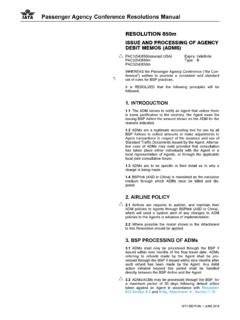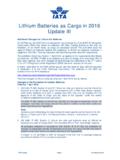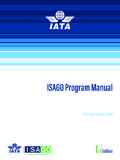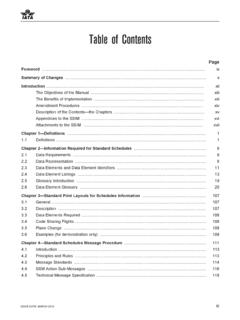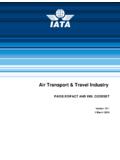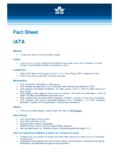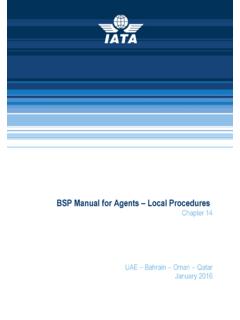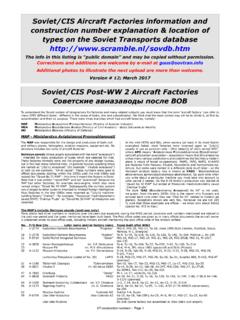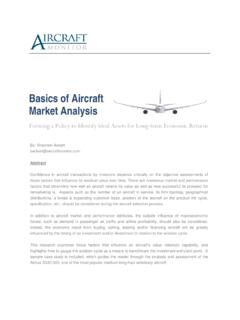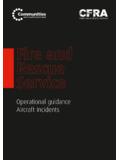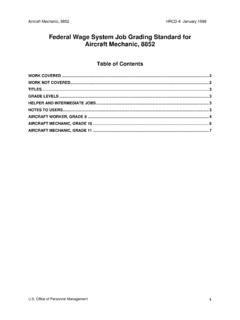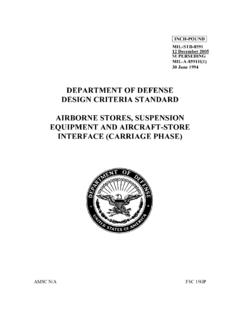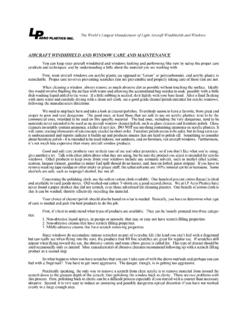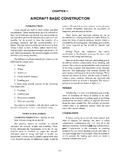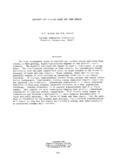Transcription of Airline Disclosure Guide - IATA
1 In association withAirline Disclosure GuideAircraft acquisition cost and depreciationPurpose of Airline Disclosure GuidesThese Airline Disclosure Guides (ADGs) have been compiled by the IATA Industry Accounting Working Group (IAWG), which consists of senior finance representatives from IATA member airlines . This working group s mandate is to promote consistency in the application of International Financial Reporting Standards (IFRS) and to lobby accounting standard setters to take into consideration the interests of airlines globally. The ADGs cover the latest accounting practices, principally from airlines reporting under IFRS related frameworks, to highlight key issues, judgements and disclosures made by airlines .
2 They are designed to help in the development and analysis of airlines annual reports. The sample for the disclosures used in the ADGs comes mainly from annual reports of members of the IAWG and of IATA s Financial ADGs are not intended as critical assessments of specific disclosures or accounting policies nor as a Guide of best practice. Furthermore, they do not provide accounting advice or detailed analysis of the underlying standards, including relevant Disclosure requirements, and they should not be used as a substitute for referring to the standards and interpretations of is a global network of member firms, providing audit, tax and advisory services and has provided the IATA IAWG with assistance in compiling the ADGs.
3 The views expressed in the ADGs are not necessarily the views of and scope3 Initial recognition of aircraft costs4 Identification of individual components7 Recognition of other associated assets9 Depreciation policies for individual components11 aircraft asset impairment and accelerated depreciation15 Sources1745123 IntroductionThe Airline industry is capital intensive and the accounting for aircraft assets has a significant impact on the financial results of airlines . aircraft are high-cost, long-life assets and contain many individual components. Orders for aircraft are often made several years in advance of delivery at prices that may include complex mechanisms for discounting the list price, including credits.
4 Payments to aircraft manufacturers may include payments for options (amounts paid in advance to secure an aircraft purchase), purchase rights, deposits and progress payments. These payments in advance of delivery can give rise to significant financing costs. In the aircraft industry, transactions are typically denominated in US Dollar and can therefore expose non-US airlines to currency risk. For the above reasons the accounting for aircraft acquisition and subsequent depreciation is complex. IAS 16 Property, Plant and Equipmentprovides clear accounting principles, but the application of these principles to aircraft and aircraft related assets often requires judgement by airlines .
5 Judgements relating to useful economic life and residual value must be revisited each reporting high value of aircraft assets carried on balance sheet coupled with earnings volatility in the industry has historically exposed airlines to potential asset impairments. This creates further accounting complexity and requires judgement in estimating the recoverable value of disclosures made by airlines in their Annual Reports provide insight into the relevant accounting judgements made including the determination of acquisition cost and the identification of individual components, their useful economic lives and their residual values. airlines also disclose their approach to asset impairment testing.
6 This ADG details the accounting guidance and examples of observed practice under International Financial Reporting Standards (IFRS) in relation to: aircraft acquisition cost and depreciationDepreciation policies for individual componentsAircraft asset impairment and accelerated depreciationInitial recognition of aircraft costs$Identification of individual componentsRecognition of other associated assets3 What acquisition costs should be capitalised?Generally, all costs incurred in bringing aircraft into working condition should be capitalised. This will include the purchase price paid for the aircraft , any related costs to making the acquisition and any adjustments to these costs or prices made as part of the purchase agreement.
7 The purchase priceTypically the manufacturer s list price is not the price that is negotiated and paid for the aircraft and the purchase will include a number of other elements. There are a wide range of fleet acquisition terms existing across the Airline industry and as a result a detailed assessment of the specific purchase agreement will be required in order to determine the final cost to be capitalised. The determination of the purchase price may be affected by the fact that manufacturers grant aircraft or engine credits to airlines as an incentive to purchase a particular aircraft or engine. These are commonly granted as part of the purchase deal with no conditions or requirements attached.
8 To the extent that these credits are in substance rebates or discounts from the purchase price they are commonly deducted against the acquisition cost of the asset capitalised on the balance related to the purchaseAdditional costs that can be capitalised can include payments for purchase rights or purchase options. These are distinct from manufacturer credits, and include amounts paid to secure the right to buy a certain aircraft at a certain time. aircraft costs may also include capitalised borrowing costs where funds are borrowed specifically, or there is a notional allocation of general indebtedness, for aircraft acquisition payments up to the point at which the aircraft asset is substantially complete.
9 Due to the nature of pre-delivery payments, capitalisation of these costs is common industry practice. IAS 23 Borrowing Costs provides the relevant accounting costs may also include the hedge gains or losses resulting from effective hedging relationships, most commonly those entered into to cover foreign exchange exposures by non-USD functional currency airlines . Guidance on hedge accounting is not covered as part of this ADG as it is the subject of a separate ADG Hedge accounting under IFRS 9 .In addition, other costs associated with acquiring the asset and bringing it to working condition may be capitalised if they meet the thresholds of IAS 16. Examples of costs that might meet this criteria could include cabin fit-outs, assembly works, with components of a purchaseWhen an asset comprises several components, each having a cost significant in relation to the overall cost of the item, IAS 16 requires that each of these components be separately identified and depreciated.
10 This typically applies for example to: airframes; engines; modifications; heavy maintenance; seats and landing Initial recognition of aircraft costs$4 Key accounting judgements and estimates Option payments and refundable deposits airlines frequently acquire options to purchase aircraft in the future, the commercial rationale being to keep aircraft acquisition capacity as flexible as possible as well as establishing a position in the manufacturer's production queue. These types of arrangements are widely referred to in the industry as options, which can provide a variety of rights, including in particular the timing of delivery or the price to be paid. If the option secures a purchase price, it would be necessary to consider if this constitutes a derivative.
